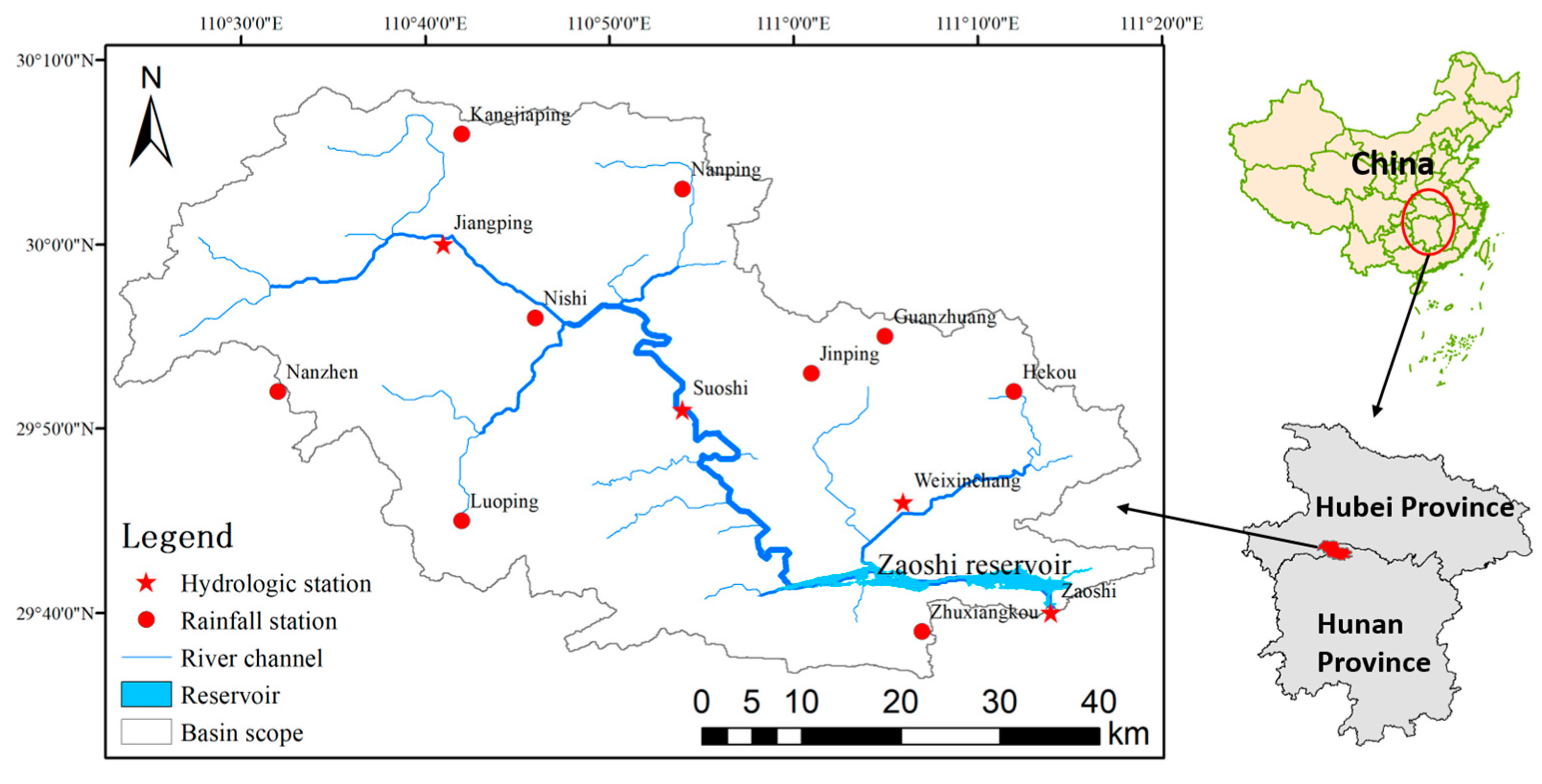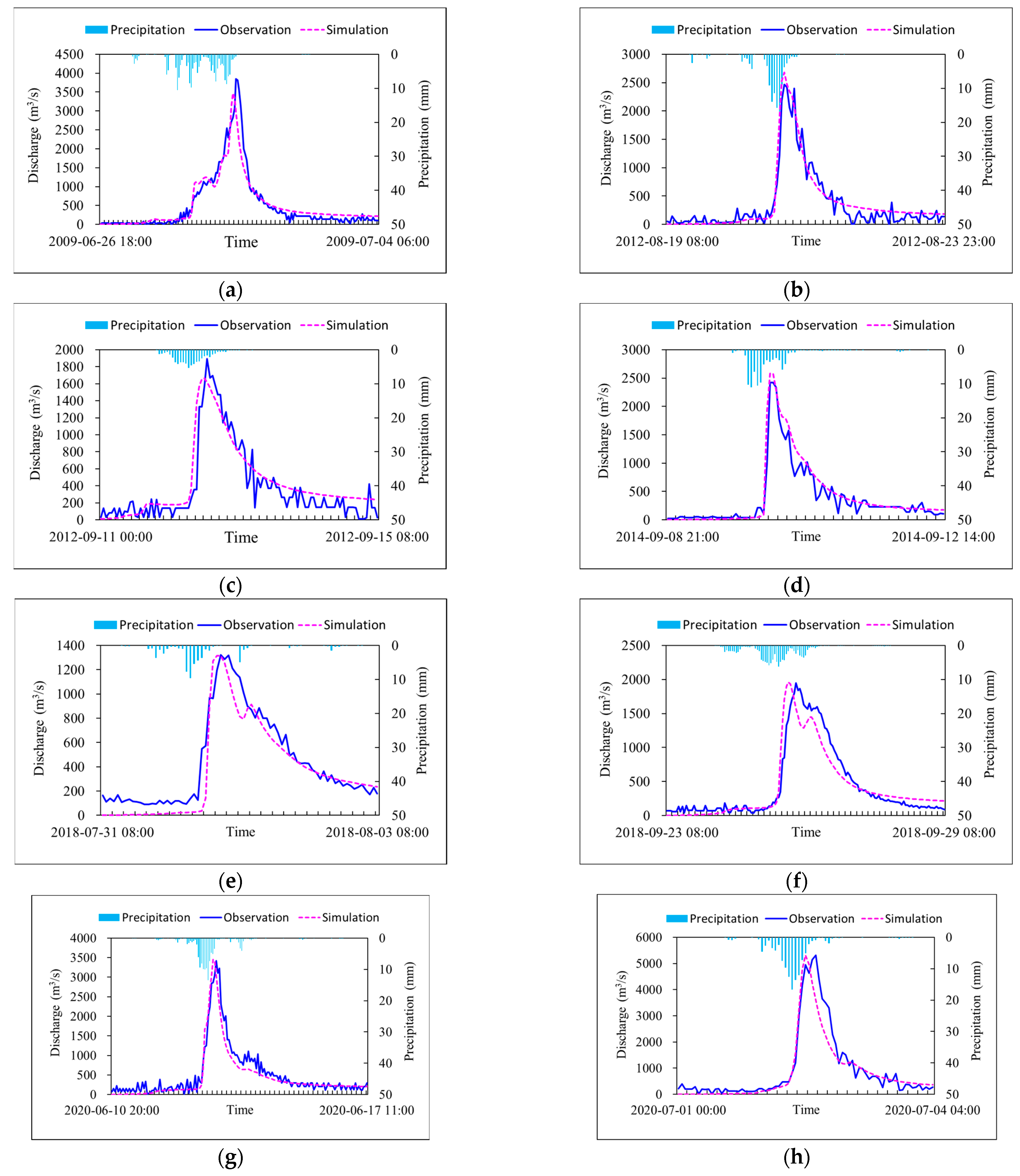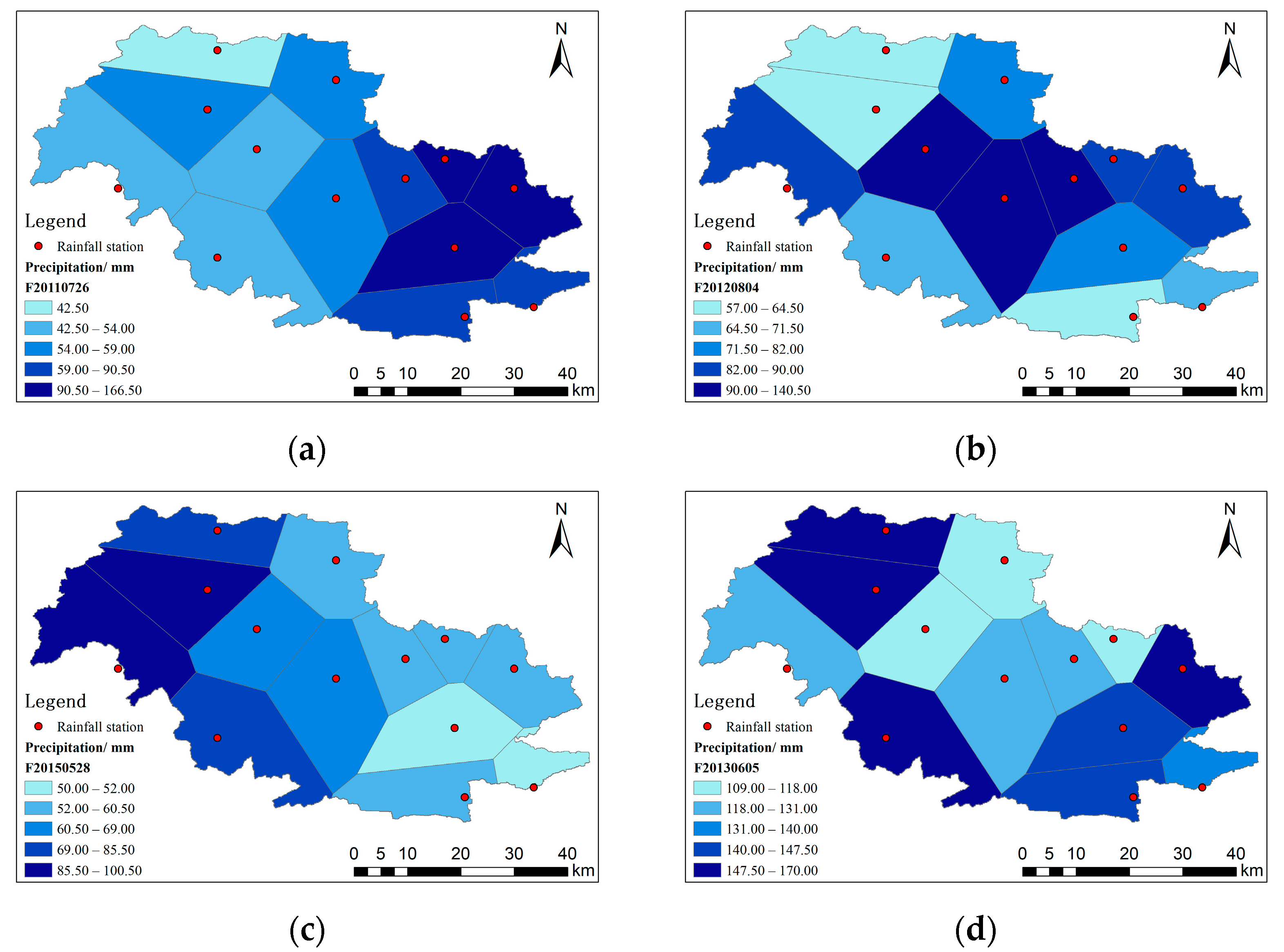Application and Research of Liuxihe Model in the Simulation of Inflow Flood at Zaoshi Reservoir
Abstract
1. Introduction
2. Materials and Methods
2.1. Liuxihe Model
2.2. Study Area
2.3. Data Collection and Processing
2.3.1. Collation of Measured Flood Data
2.3.2. Watershed Physical Characteristics Data Collection, Analysis and Collation
2.4. Construction of Liuxihe Model
2.4.1. Watershed Division and Cell Type Determination
2.4.2. Initial Model Parameters
2.4.3. Model Parameter Optimization
3. Results and Discussion
3.1. Flood Simulation Results
3.2. Model Performance Evaluation
3.3. Simulation to Flood with Uneven Precipitation Spatial Distribution
3.4. Analysis of Model Parameter Optimization Results
4. Conclusions
- Each rainfall event analyzed in this paper exhibits an uneven spatial distribution, and the floods can be divided into four types: downstream, midstream, upstream, and irregular.
- In this study, the Liuxihe model’s flood inflow forecasting scheme for the Zaoshi Reservoir showed an excellent simulation effect, with an average peak simulation accuracy of 96.3%, average peak time of 1.042 h early, and average Nash–Sutcliffe coefficient of 0.799. Under the condition of an uneven spatial distribution of rainfall, the Liuxihe model simulates floods well. Thus, flood simulation with the Liuxihe model is ideal for the watershed above the Zaoshi Reservoir, and the model can be applied in operational flood forecasting.
- The PSO algorithm significantly improved the simulation precision of the Liuxihe model, and its practical application requires only the selection of a typical flood for parameter optimization, thereby effectively improving the model’s performance.
Author Contributions
Funding
Institutional Review Board Statement
Informed Consent Statement
Data Availability Statement
Conflicts of Interest
References
- DeVries, B.; Huang, C.; Armston, J.; Huang, W.; Jones, J.W.; Lang, M.W. Rapid and robust monitoring of flood events using Sentinel-1 and Landsat data on the Google Earth Engine. Remote Sens. Environ. 2020, 240, 111664. [Google Scholar] [CrossRef]
- Wang, G.; Liu, Y.; Hu, Z.; Lyu, Y.; Zhang, G.; Liu, J.; Liu, Y.; Gu, Y.; Huang, X.; Zheng, H.; et al. Flood risk assessment based on fuzzy synthetic evaluation method in the Beijing-Tianjin-Hebei metropolitan area, China. Sustainability 2020, 12, 1451. [Google Scholar] [CrossRef]
- Török, I. Qualitative assessment of social vulnerability to flood hazards in Romania. Sustainability 2018, 10, 3780. [Google Scholar] [CrossRef]
- Zhang, M.; Xiang, W.; Chen, M.; Mao, Z. Measuring social vulnerability to flood disasters in China. Sustainability 2018, 10, 2676. [Google Scholar] [CrossRef]
- Choi, H.I. Spatial assessment of damage vulnerability to storms based on the analysis of historical damage cost data in the Korean Peninsula. Sustainability 2019, 11, 6051. [Google Scholar] [CrossRef]
- Urban, M.C. Accelerating extinction risk from climate change. Science 2015, 348, 571–573. [Google Scholar] [CrossRef]
- O’Gorman, P.A. Precipitation extremes under climate change. Curr. Clim. Chang. Rep. 2015, 1, 49–59. [Google Scholar] [CrossRef]
- Kabiso, A.F.; O’Neill, E.; Brereton, F.; Abeje, W. Rapid Urbanization in Ethiopia: Lakes as Drivers and Its Implication for the Management of Common Pool Resources. Sustainability 2022, 14, 12788. [Google Scholar] [CrossRef]
- Bremard, T. Monitoring land subsidence: The challenges of producing knowledge and groundwater management indicators in the Bangkok metropolitan region, Thailand. Sustainability 2022, 14, 10593. [Google Scholar] [CrossRef]
- Huong, H.T.L.; Pathirana, A. Urbanization and climate change impacts on future urban flooding in Can Tho city, Vietnam. Hydrol. Earth Syst. Sci. 2013, 17, 379–394. [Google Scholar] [CrossRef]
- Miller, J.D.; Hutchins, M. The impacts of urbanisation and climate change on urban flooding and urban water quality: A review of the evidence concerning the United Kingdom. J. Hydrol. Reg. Stud. 2017, 12, 345–362. [Google Scholar] [CrossRef]
- Zhang, K.; Gann, D.; Ross, M.; Robertson, Q.; Sarmiento, J.; Santana, S.; Rhome, J.; Fritz, C. Accuracy assessment of ASTER, SRTM, ALOS, and TDX DEMs for Hispaniola and implications for mapping vulnerability to coastal flooding. Remote Sens. Environ. 2019, 225, 290–306. [Google Scholar] [CrossRef]
- Quesada-Román, A. Flood risk index development at the municipal level in Costa Rica: A methodological framework. Environ. Sci. Policy 2022, 133, 98–106. [Google Scholar] [CrossRef]
- Chen, C.; Jiang, J.; Zhou, Y.; Lv, N.; Liang, X.; Wan, S. An edge intelligence empowered flooding process prediction using Internet of things in smart city. J. Parallel Distrib. Comput. 2022, 165, 66–78. [Google Scholar] [CrossRef]
- Chen, L.; Chen, Y.; Zhang, Y.; Xu, S. Spatial patterns of typhoon rainfall and associated flood characteristics over a mountainous watershed of a tropical island. J. Hydrol. 2022, 613, 128421. [Google Scholar] [CrossRef]
- Rui, X. On watershed hydrological model. Adv. Water Conserv. Hydropower Technol. 2017, 37, 1–7+58. [Google Scholar]
- Jie, M.X.; Chen, H.; Xu, C.Y.; Zeng, Q.; Tao, X.E. A comparative study of different objective functions to improve the flood forecasting accuracy. Hydrol. Res. 2016, 47, 718–735. [Google Scholar] [CrossRef]
- Lu, M. Review and Prospect of Xin’anjiang Model Research. J. Water Resour. 2021, 52, 432–441. [Google Scholar]
- Du, J.; Qian, L.; Rui, H.; Zuo, T.; Zheng, D.; Xu, Y.; Xu, C.Y. Assessing the effects of urbanization on annual runoff and flood events using an integrated hydrological modeling system for Qinhuai River basin, China. J. Hydrol. 2012, 464, 127–139. [Google Scholar] [CrossRef]
- Freeze, R.A.; Harlan, R.L. Blueprint for a physically-based, digitally-simulated hydrologic response model. J. Hydrol. 1969, 9, 237–258. [Google Scholar] [CrossRef]
- Abbott, M.B.; Bathurst, J.C.; Cunge, J.A.; O’Connell, P.E.; Rasmussen, J. An introduction to the European Hydrological System-Systeme Hydrologique Europeen, “SHE”, 2:structure of a physically based, distributed modeling system. J. Hydrol. 1986, 87, 61–77. [Google Scholar] [CrossRef]
- Liang, X.; Lettenmaier, D.P.; Wood, E.F.; Burges, S.J. A simple hydrologically based model of land surface water and energy fluxes for general circulation models. J. Geophys. Res. 1994, 99, 14415–14428. [Google Scholar] [CrossRef]
- Wang, Z.; Batelaan, O.; Smedt, F.D. A distributed model for water and energy transfer between soil, plants and atmosphere (WetSpa). Phys. Chem. Earth 1996, 21, 189–193. [Google Scholar] [CrossRef]
- Vieux, J.; Ceo, P. Vflo™: A real-time distributed hydrologic model. In Proceedings of the 2nd Federal Interagency Hydrologic Modeling Conference, Las Vegas, NV, USA, 28 July–1 August 2002; pp. 1–12. [Google Scholar]
- Li, L.; Zhong, M. Structure of LL-Ⅱ distributed rainfall runoff model based on GIS. Hydropower Energy Sci. 2003, 21, 35–38. [Google Scholar]
- Chen, Y. Liuxihe Model; Science Press: Beijing, China, 2009; 198p. [Google Scholar]
- Wang, D.; Tan, D.; Liu, L. Particle swarm optimization algorithm: An overview. Soft Comput. 2018, 22, 387–408. [Google Scholar] [CrossRef]
- Zhang, Y.; Wang, S.; Ji, G. A comprehensive survey on particle swarm optimization algorithm and its applications. Math. Probl. Eng. 2015, 2015, 931256. [Google Scholar] [CrossRef]
- Xue, B.; Zhang, M.; Browne, W.N. Particle swarm optimization for feature selection in classification: A multi-objective approach. IEEE Trans. Cybern. 2012, 43, 1656–1671. [Google Scholar] [CrossRef]
- Bonyadi, M.R.; Michalewicz, Z. Particle swarm optimization for single objective continuous space problems: A review. Evol. Comput. 2017, 25, 1–54. [Google Scholar] [CrossRef]
- Chen, Y.; Ren, Q.; Huang, F.; Xu, H.; Cluckie, I. Liuxihe Model and Its Modeling to River Basin Flood. J. Hydrol. Eng. 2011, 16, 33–50. [Google Scholar] [CrossRef]
- Zhou, F.; Chen, Y.; Wang, L.; Wu, S.; Shao, G. Flood forecasting scheme of Nanshui reservoir based on Liuxihe model. Trop. Cyclone Res. Rev. 2021, 10, 106–115. [Google Scholar] [CrossRef]
- Li, J.; Hong, A.; Yuan, D.; Jiang, Y.; Zhang, Y.; Deng, S.; Cao, C.; Liu, J.; Chen, Y. Elaborate simulations and forecasting of the effects of urbanization on karst flood events using the improved Karst-Liuxihe model. Catena 2020, 197, 104990. [Google Scholar] [CrossRef]
- Yang, T.; Rao, S.; Liao, C.; Zhou, D.; Zhang, Y. Preliminary study on forecast of incoming discharge of Zaoshi Reservoir. Water Technol. Econ. 2017, 23, 58–62. [Google Scholar]
- Fiedler, F.R. Simple, practical method for determining station weights using Thiessen polygons and isohyetal maps. J. Hydrol. Eng. 2003, 8, 219–221. [Google Scholar] [CrossRef]
- Panigrahy, N.; Jain, S.K.; Kumar, V.; Bhunya, P.K. Algorithms for computerized estimation of Thiessen weights. J. Comput. Civ. Eng. 2009, 23, 239–247. [Google Scholar] [CrossRef]
- Zhu, Q.A.; Zhang, W.C.; Zhao, D.Z. Topography-based spatial daily precipitation interpolation by means of PRISM and Thiessen polygon analysis. Sci. Geogr. Sin. 2005, 25, 233–238. [Google Scholar]
- O’Callaghan, J.F.; Mark, D.M. The extraction of drainage networks from digital elevation data. Comput. Vis. Graph. Image Process. 1984, 28, 323–344. [Google Scholar] [CrossRef]
- Strahler, A.N. Quantitative analysis of watershed geomorphology. Trans.—Am. Geophys. Union 1957, 38, 913–920. [Google Scholar] [CrossRef]
- Arya, L.M.; Paris, J.F. A Physicoempirical Model to Predict the Soil Moisture Characteristic from Particle-Size Distribution and Bulk Density Data. Soil Sci. Soc. Am. J. 1981, 45, 1023–1030. [Google Scholar] [CrossRef]
- Kennedy, J.; Eberhart, R. Particle swarm optimization. In Proceedings of the ICNN’95-International Conference on Neural Networks, Perth, WA, Australia, 27 November–1 December 1995; Volume 4, pp. 1942–1948. [Google Scholar]
- Shi, Y. Particle swarm optimization: Developments, applications and resources. In Proceedings of the 2001 Congress on Evolutionary Computation (IEEE Cat. No. 01TH8546), Seoul, Republic of Korea, 27–30 May 2001; Volume 1, pp. 81–86. [Google Scholar]
- Zhao, Y.; Chen, Y.; Zhu, Y.; Xu, S. Evaluating the Feasibility of the Liuxihe Model for Forecasting Inflow Flood to the Fengshuba Reservoir. Water 2023, 15, 1048. [Google Scholar] [CrossRef]









| Flood Event No. | Duration (h) | Total Rainfall (mm) | Peak Discharge (m3/s) |
|---|---|---|---|
| 20090607 | 96 | 110.50 | 2293 |
| 20090626 | 181 | 167.31 | 3842 |
| 20100503 | 88 | 68.58 | 1147 |
| 20110613 | 73 | 91.35 | 2111 |
| 20110617 | 78 | 186.85 | 8622 |
| 20110726 | 72 | 77.96 | 1200 |
| 20120625 | 96 | 159.35 | 3235 |
| 20120804 | 120 | 87.08 | 1764 |
| 20120819 | 112 | 109.12 | 2462 |
| 20120911 | 105 | 62.15 | 1890 |
| 20130605 | 96 | 139.23 | 5010 |
| 20130720 | 75 | 87.04 | 2361 |
| 20130923 | 120 | 141.15 | 2334 |
| 20140724 | 77 | 66.27 | 1190 |
| 20140908 | 90 | 87.92 | 2417 |
| 20141027 | 119 | 193.31 | 3269 |
| 20150528 | 96 | 68.08 | 1641 |
| 20160618 | 97 | 180.46 | 4222 |
| 20160626 | 91 | 80.00 | 2568 |
| 20180731 | 73 | 58.42 | 1321 |
| 20180923 | 145 | 114.50 | 1948 |
| 20190524 | 97 | 79.08 | 1354 |
| 20200610 | 160 | 119.00 | 3423 |
| 20200701 | 77 | 115.46 | 5312 |
| 20200704 | 103 | 182.88 | 4588 |
| Order | FA0 | Number of Channel Cells | Proportion of Channel Cells (%) |
|---|---|---|---|
| 6 | 25 | 43,937 | 11.9 |
| 5 | 187 | 16,578 | 4.5 |
| 4 | 681 | 8811 | 2.4 |
| 3 | 4300 | 3715 | 1.0 |
| 2 | 25,682 | 1458 | 0.4 |
| 1 | 68,274 | 995 | 0.3 |
| Land Use Type | Evaporation Coefficient | Slope Roughness Coefficient |
|---|---|---|
| Evergreen coniferous forest | 0.7 | 0.4 |
| Evergreen broad-leaved forest | 0.7 | 0.6 |
| Shrubs | 0.7 | 0.4 |
| Thin forest | 0.7 | 0.3 |
| Cultivated land | 0.7 | 0.15 |
| Soil Type | Thickness of Soil Layer (mm) | Saturated Water Content | Field Moisture Retention | Saturated Hydraulic Conductivity | Soil Porosity Characteristics | Wilting Moisture Content |
|---|---|---|---|---|---|---|
| CN10051 | 1000 | 0.508 | 0.411 | 2.19 | 2.5 | 0.28 |
| CN30115 | 900 | 0.449 | 0.26 | 17.27 | 2.5 | 0.137 |
| CN30119 | 1000 | 0.509 | 0.387 | 4.71 | 2.5 | 0.231 |
| CN30139 | 1140 | 0.495 | 0.385 | 3.36 | 2.5 | 0.244 |
| CN30149 | 1300 | 0.429 | 0.211 | 24.13 | 2.5 | 0.132 |
| CN30151 | 750 | 0.481 | 0.354 | 5.3 | 2.5 | 0.207 |
| CN30173 | 580 | 0.434 | 0.222 | 22.71 | 2.5 | 0.132 |
| CN30179 | 1190 | 0.482 | 0.33 | 9.85 | 2.5 | 0.158 |
| CN30193 | 550 | 0.458 | 0.221 | 37.34 | 2.5 | 0.082 |
| CN30199 | 630 | 0.491 | 0.416 | 1.04 | 2.5 | 0.293 |
| CN30255 | 1100 | 0.538 | 0.44 | 2.17 | 2.5 | 0.326 |
| CN40045 | 1300 | 0.446 | 0.272 | 13.18 | 2.5 | 0.154 |
| CN50025 | 1550 | 0.46 | 0.252 | 24.89 | 2.5 | 0.104 |
| CN60165 | 750 | 0.465 | 0.35 | 3.91 | 2.5 | 0.219 |
| CN60315 | 700 | 0.477 | 0.299 | 18.08 | 2.5 | 0.099 |
| Nash–Sutcliffe Coefficient | Correlation Coefficient | Process Relative Error | Peak Error | Water Balance Coefficient | Peak Time Error | |
|---|---|---|---|---|---|---|
| Before optimization | 0.746 | 0.938 | 1.212 | 0.443 | 0.911 | −1 |
| After optimization | 0.954 | 0.979 | 0.373 | 0.028 | 0.946 | −2 |
| Flood Event Serial Number | Nash–Sutcliffe Coefficient | Correlation Coefficient | Process Relative Error | Peak Error | Water Balance Coefficient | Peak Time Error |
|---|---|---|---|---|---|---|
| 20090626 | 0.899 | 0.956 | 0.733 | 0.097 | 1.017 | −2 |
| 20100503 | 0.785 | 0.903 | 0.675 | 0.015 | 1.054 | −3 |
| 20110613 | 0.839 | 0.938 | 0.644 | 0.028 | 1.097 | −2 |
| 20110617 | 0.881 | 0.944 | 0.442 | 0.01 | 0.86 | −1 |
| 20110726 | 0.764 | 0.882 | 1.022 | 0.003 | 1.077 | −2 |
| 20120625 | 0.737 | 0.874 | 0.574 | 0.012 | 1.072 | 0 |
| 20120804 | 0.641 | 0.885 | 1.699 | 0.011 | 1.222 | 0 |
| 20120819 | 0.918 | 0.964 | 1.952 | 0.087 | 1.074 | 0 |
| 20120911 | 0.841 | 0.926 | 1.431 | 0.12 | 1.153 | −1 |
| 20130605 | 0.92 | 0.96 | 0.496 | 0.003 | 0.935 | −3 |
| 20130720 | 0.852 | 0.94 | 0.585 | 0.007 | 1.231 | 2 |
| 20130923 | 0.921 | 0.96 | 0.761 | 0.068 | 1.028 | −2 |
| 20140724 | 0.641 | 0.871 | 1.388 | 0.004 | 1.255 | −1 |
| 20140908 | 0.904 | 0.972 | 0.458 | 0.067 | 1.134 | 1 |
| 20141027 | 0.941 | 0.972 | 0.528 | 0.081 | 0.994 | 0 |
| 20150528 | 0.459 | 0.858 | 1.613 | 0.006 | 1.452 | −3 |
| 20160618 | 0.628 | 0.837 | 1.904 | 0.063 | 1.115 | −2 |
| 20160626 | 0.867 | 0.945 | 0.298 | 0.015 | 0.87 | −3 |
| 20180731 | 0.871 | 0.954 | 0.418 | 0.003 | 0.843 | 0 |
| 20180923 | 0.878 | 0.938 | 0.502 | 0.006 | 0.948 | −4 |
| 20190524 | 0.474 | 0.782 | 0.511 | 0.015 | 0.701 | −3 |
| 20200610 | 0.91 | 0.961 | 0.442 | 0.008 | 0.849 | −2 |
| 20200701 | 0.902 | 0.956 | 0.496 | 0.0001 | 0.878 | −3 |
| 20200704 | 0.698 | 0.924 | 0.35 | 0.154 | 0.721 | 9 |
| Average value | 0.799 | 0.921 | 0.830 | 0.037 | 1.024 | −1.042 |
| Average Nash–Sutcliffe Coefficient | Average Correlation Coefficient | Average Process Relative Error | Average Peak Error | Average Water Balance Coefficient | Average Peak Time Error | |
|---|---|---|---|---|---|---|
| Initial model parameter | 0.548 | 0.841 | 2.430 | 0.425 | 1.076 | −0.167 |
| Optimized parameter | 0.799 | 0.921 | 0.830 | 0.037 | 1.024 | −1.042 |
Disclaimer/Publisher’s Note: The statements, opinions and data contained in all publications are solely those of the individual author(s) and contributor(s) and not of MDPI and/or the editor(s). MDPI and/or the editor(s) disclaim responsibility for any injury to people or property resulting from any ideas, methods, instructions or products referred to in the content. |
© 2023 by the authors. Licensee MDPI, Basel, Switzerland. This article is an open access article distributed under the terms and conditions of the Creative Commons Attribution (CC BY) license (https://creativecommons.org/licenses/by/4.0/).
Share and Cite
Zhu, Y.; Chen, Y.; Zhao, Y.; Zhou, F.; Xu, S. Application and Research of Liuxihe Model in the Simulation of Inflow Flood at Zaoshi Reservoir. Sustainability 2023, 15, 9857. https://doi.org/10.3390/su15139857
Zhu Y, Chen Y, Zhao Y, Zhou F, Xu S. Application and Research of Liuxihe Model in the Simulation of Inflow Flood at Zaoshi Reservoir. Sustainability. 2023; 15(13):9857. https://doi.org/10.3390/su15139857
Chicago/Turabian StyleZhu, Yanzheng, Yangbo Chen, Yanjun Zhao, Feng Zhou, and Shichao Xu. 2023. "Application and Research of Liuxihe Model in the Simulation of Inflow Flood at Zaoshi Reservoir" Sustainability 15, no. 13: 9857. https://doi.org/10.3390/su15139857
APA StyleZhu, Y., Chen, Y., Zhao, Y., Zhou, F., & Xu, S. (2023). Application and Research of Liuxihe Model in the Simulation of Inflow Flood at Zaoshi Reservoir. Sustainability, 15(13), 9857. https://doi.org/10.3390/su15139857









